-
Product Name
ACSL1 antibody
- Documents
-
Description
ACSL1 Rabbit Polyclonal antibody. Positive IP detected in mouse liver tissue. Positive WB detected in HepG2 cells, human cerebellum tissue, rat liver tissue. Positive IF detected in HepG2 cells. Positive IHC detected in human liver cancer tissue, human heart tissue. Observed molecular weight by Western-blot: 68 kDa,78 kDa
-
Tested applications
ELISA, WB, IHC, IP, IF
-
Species reactivity
Human,Mouse,Rat; other species not tested.
-
Alternative names
ACS1 antibody; ACSL1 antibody; Acyl CoA synthetase 1 antibody; FACL1 antibody; FACL2 antibody; LACS antibody; LACS 1 antibody; LACS 2 antibody; LACS1 antibody; LACS2 antibody; Palmitoyl CoA ligase 1 antibody; Palmitoyl CoA ligase 2 antibody
- Immunogen
-
Isotype
Rabbit IgG
-
Preparation
This antibody was obtained by immunization of ACSL1 recombinant protein (Accession Number: XM_005262829). Purification method: Antigen affinity purified.
-
Clonality
Polyclonal
-
Formulation
PBS with 0.02% sodium azide and 50% glycerol pH 7.3.
-
Storage instructions
Store at -20℃. DO NOT ALIQUOT
-
Applications
Recommended Dilution:
WB: 1:200-1:2000
IP: 1:200-1:2000
IHC: 1:20-1:200
IF: 1:20-1:200
-
Validations
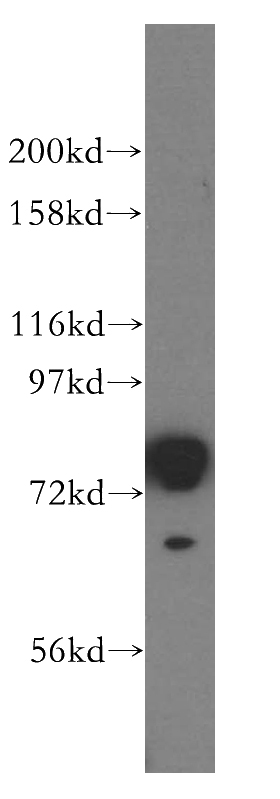
HepG2 cells were subjected to SDS PAGE followed by western blot with Catalog No:107695(ACSL1 antibody) at dilution of 1:800
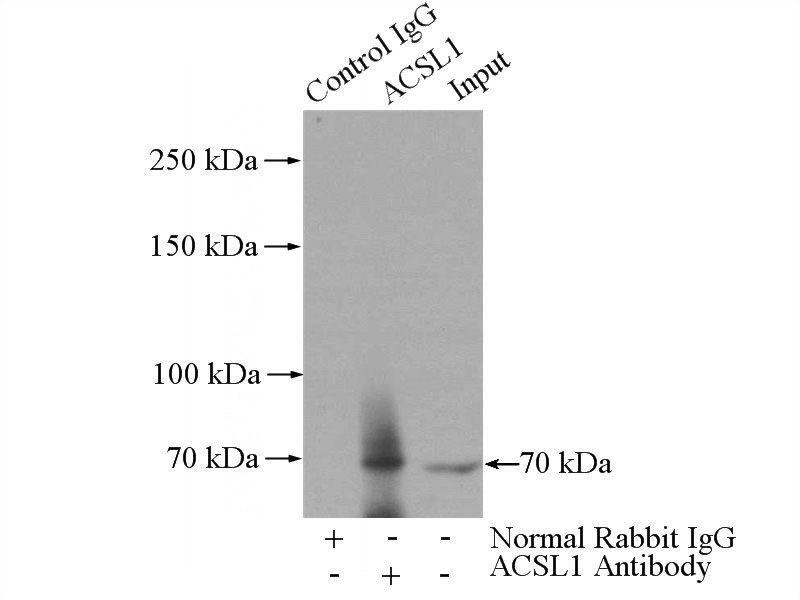
IP Result of anti-ACSL1 (IP:Catalog No:107695, 4ug; Detection:Catalog No:107695 1:600) with mouse liver tissue lysate 4000ug.
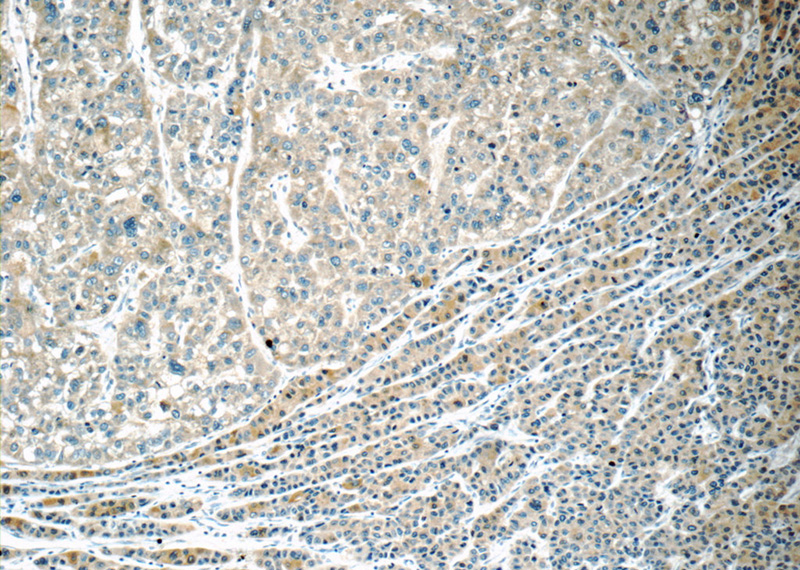
Immunohistochemistry of paraffin-embedded human liver cancer tissue slide using Catalog No:107695(ACSL1 Antibody) at dilution of 1:50 (under 10x lens)
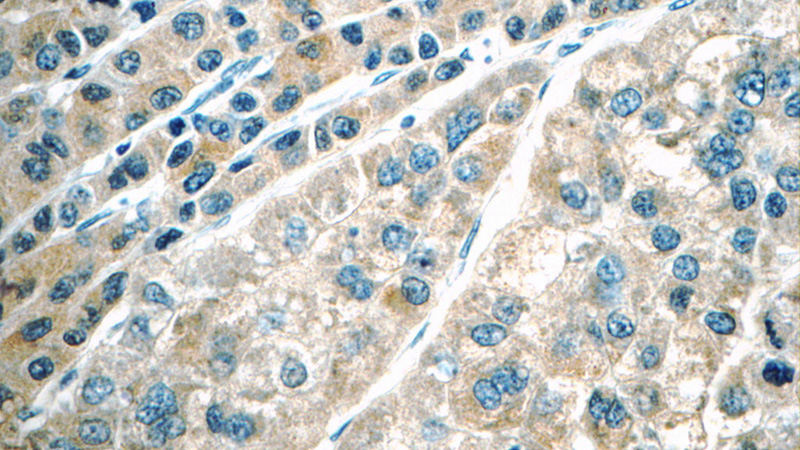
Immunohistochemistry of paraffin-embedded human liver cancer tissue slide using Catalog No:107695(ACSL1 Antibody) at dilution of 1:50 (under 40x lens)
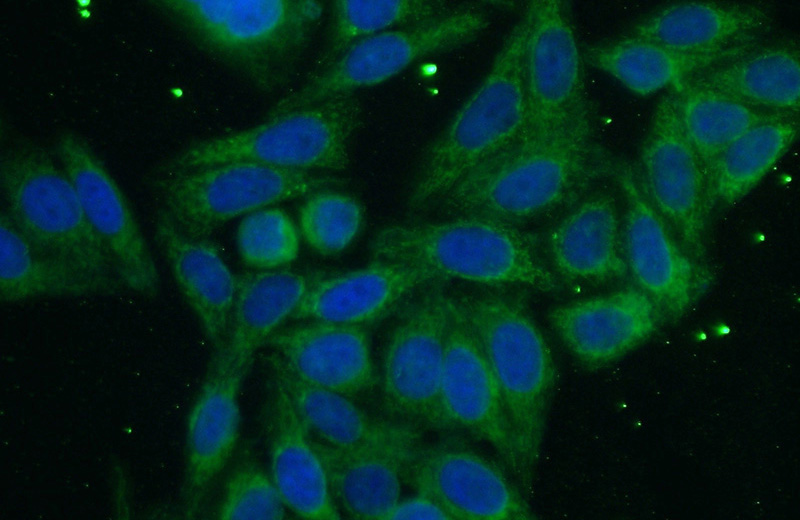
Immunofluorescent analysis of (10% Formaldehyde) fixed HepG2 cells using Catalog No:107695(ACSL1 Antibody) at dilution of 1:50 and Alexa Fluor 488-congugated AffiniPure Goat Anti-Rabbit IgG(H+L)
-
Background
ACSL1(Long-chain-fatty-acid--CoA ligase 1) is also named as FACL1, FACL2, LACS, LACS1, LACS2 and belongs to the ATP-dependent AMP-binding enzyme family. ACSL1 is a 75 kDa protein that is associated peripherally with the plasma membrane(Brian M Wiczer, etc., 2006). ACSL1 is abundantly expressed in tissues, such as liver and brown fat, that metabolize substantial amounts of triglycerides as fuel, and as such, a deficiency in ACSL1 function could have a more profound affect in those cells, resulting in hepatosteatosis and potentially increased very low density lipoprotein production by the liver or decreased thermogenic capacity in brown adipose tissue(PMID:19429676). An anti-rat ACSL1 antibody recognized a band of the predicted 68 kDa in high-speed supernatant from rat liver and in human and murine SMCs, monocyte-derived macrophages, and murine peritoneal macrophages (PMID:17259370). It has 2 isoforms produced by alternative splicing.
-
References
- Cui M, Wang Y, Sun B, Xiao Z, Ye L, Zhang X. MiR-205 modulates abnormal lipid metabolism of hepatoma cells via targeting acyl-CoA synthetase long-chain family member 1 (ACSL1) mRNA. Biochemical and biophysical research communications. 444(2):270-5. 2014.
- Huang D, Li T, Li X. HIF-1-mediated suppression of acyl-CoA dehydrogenases and fatty acid oxidation is critical for cancer progression. Cell reports. 8(6):1930-42. 2014.
- Liu M, Xu L, Yin L. Potent effects of dioscin against obesity in mice. Scientific reports. 5:7973. 2015.
- Cui M, Xiao Z, Wang Y. Long noncoding RNA HULC modulates abnormal lipid metabolism in hepatoma cells through an miR-9-mediated RXRA signaling pathway. Cancer research. 75(5):846-57. 2015.
- Wang MD, Wu H, Fu GB. Acetyl-CoA carboxylase α promotion of glucose-mediated fatty acid synthesis enhances survival of hepatocellular carcinoma in mice and patients. Hepatology (Baltimore, Md.). 2015.
- Liu T, Yang LL, Zou L. Chinese medicine formula lingguizhugan decoction improves Beta-oxidation and metabolism of Fatty Acid in high-fat-diet-induced rat model of Fatty liver disease. Evidence-based complementary and alternative medicine : eCAM. 2013:429738. 2013.
- Xu T, Zheng L, Xu L. Protective effects of dioscin against alcohol-induced liver injury. Archives of toxicology. 88(3):739-53. 2014.
Related Products / Services
Please note: All products are "FOR RESEARCH USE ONLY AND ARE NOT INTENDED FOR DIAGNOSTIC OR THERAPEUTIC USE"
